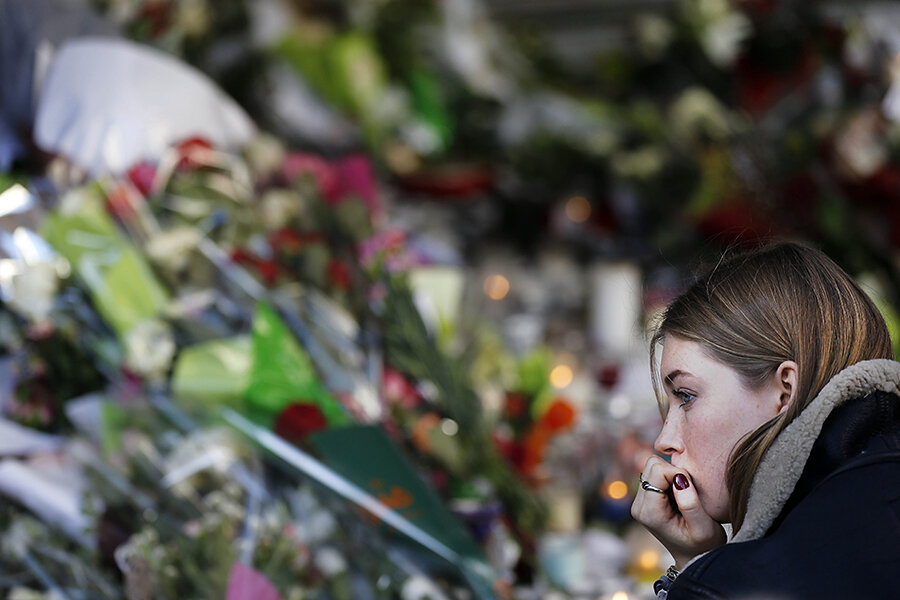Bataclan Generation: For Paris youths, ISIS attack hit hard
Loading...
| Paris
If any place is the stomping ground of the young in Paris, it is here in the 10th and 11th arrondissements, in the trendy cafés by the Canal Saint Martin and the buzzing bars near Bastille. So when terrorists opened fire along the Rue de Charonne and the Rue Alibert and inside the Bataclan concert hall, it disproportionately hit Parisians in their 20s and 30s.
Many young Parisians have a simple question. Why?
Is it because it is here where the bohemian and artistic spirit the French capital was once known for is concentrated in its modern-day equivalent, a lifestyle that terrorists deem decadent and worth destroying?
Is it because these terrorists – also young, like so many of the European Jihadis lured to Islamic State are – starkly see themselves stuck behind a social divide?
Was it simply because the young tend to congregate in densely packed venues?
As youths search for answers, they are already being dubbed the “Bataclan generation,” as the French daily Liberation put on their front page, and the social and political consequences are likely to reverberate for years and decades to come.
While it hurts now, some of its impact could be steered toward tremendous good, says Benoit Bayle, a psychiatrist in Chartres, France. “Everyone will react differently, but one could imagine that in an ambiance of security, peace, and material wellbeing, these events can bring to the forefront the sense that life is precarious,” he says. “But this in itself can become a positive angle for an individual who can try to do something meaningful with life precisely because he or she is now aware that life can be gone from one day to the next.”
'It could have been us'
For right now, most young people are working through the immediate pain. Marie Duval, who works in the audiovisual field, often visits the locales on Rue de Charonne with her boyfriend, Romain Nap. Both in their later 20s, they are devastatingly aware that they easily could have been tallied in a death toll that stands near 130 and could yet inch up, with dozens still critically injured from gunshot wounds and explosions.
Instead, she’s at La Belle Equipe, one of the restaurants targeted on Friday, to “share her grief,” and “feel containment” for the death of a former schoolmate who was shot by terrorists on a Friday night that drew hordes outside to enjoy an unseasonably balmy evening. Eighteen others died here as well.
“I’m sad, and I fear,’’ says Ms. Duval. “These are the places we go to. For the first time, we feel like targets. It could have been us.”
The attacks on the satirical magazine Charlie Hebdo were also near here, but in that attack the target was clear: journalists who terrorists say deserved to die because they mocked Islam. Here the targets find no motivation, no easy answers. “This is about people,” says Mr. Nap, “particularly young people.’’
And, perhaps most disconcerting, it’s about people who were having fun. One tweet expressed it poignantly, with the trending hashtag #MonplusbeausouvenirduBataclan, or “My most beautiful memory from the Bataclan.” The poster writes, “We were just the kids in the dark.”
'Construct something positive'
With the exception of the Stade de France sports arena, in the northern suburb of Saint Denis, the terrorists unleashed their fire only here – and some see this as no coincidence. This area has a multicultural edge, a heritage of its working class days. It's also a magnet for the “bobo” set, a French code-word for bourgeois-bohemian, young families drawn for what was once cheaper rent, and those who simply like an edgier vibe.
For Ronan Orio, a psychiatrist who specializes in terrorist attacks, Friday’s events hit a demographic that is cosmopolitan, educated, and perhaps, from some vantages, “too confident of itself.” In that sense, the attacks present a clash of two different realities that co-exist in France, he says, one that is privileged, and another completely left behind. “You have a community of people who are now French, but hate France,” he says.
To be sure, the shock of the events are not limited to the young, to Paris, France, or just to Europe. They’ve impacted the globe. But east Paris is at the front lines. And the city is responding. In the 11th district town hall, the government has deployed psychologists to receive people who need counseling. Visitors of all age groups stop to leave condolences in a book left outside.
For Dr. Bayle, it is critical now that society supports them through their experience. “It is important to accompany the young in the idea that out of a dramatic event, they can construct something positive out of it,’’ he says.
Pierre Cappelaere and his girlfriend Elisa Guffens, both in their early 20s, live in the area and were just down the road from La Belle Equipe on Friday night. They are still visibly shocked, containing tears as they come to render their tribute to the café, now closed and adorned with a spread of flowers and candles that continues to grow. They repeat the words that are too often heard among their group. Says Ms. Guffens: “We all know someone who knows someone."





